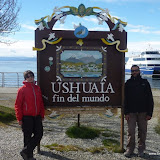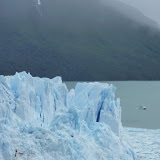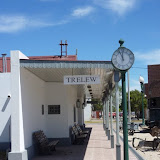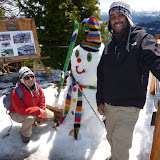We are now away from the Andes and close to the Atlantic ocean. The landscape have changed : mountains, lakes and monkey puzzle tree forests have been replaced by flat and arid Patagonian steppe.

Towns in this area were founded by Welsh immigrants who colonised the fertile lowlands of Chubut river back in the second half of 19th century. The culture brought along by the forefathers is still present nowadays : brick houses with woodwork doors, flowery gardens, associations and schools of traditional Welsh music, tea houses. Indeed, Argentinians of welsh descent, even those coming from mixed families, can still speak the language of their ancestors. Walking around Gaiman, a small village near Trelew, taking note of the likenesses with the United Kingdom, hearing two young mothers with their pushchairs speaking to each other in welsh, and enjoying a five o'clock tea with a selection of typical pastries in one of the many tea houses spread around the village, is a funny and fascinating experience (and on top of that, cakes were really good, yum yum !)
But as you can imagine from our last post, we did not cross Argentina from west to east just for the great tea and pastries (we have got Morocco for that). It is the wildlife that can be seen in Valdes Peninsula and the other natural reserves of the area that brought us here. Since distances are big (we made some 900 km in two days) and we did not want to be dependant on organised trips, we rented a car. It felt good to be behind the steering wheel for a change.
There were animals to satisfy everyone : guanacos (a camelid of the same family as llamas, vicunas and alpacas), rheas (a kind of ostrich), cuis (a little fast rabbit whose first cousin I ate in Peru), sea lions, elephant seals (the biggest males weighting up to 2500 kilos), pink flamingos and plenty of other birds.

However, the show queens are the whales. At this time of the year, they visit these shores to reproduce and raise their little ones. It is possible to see them just by walking on the beach in Puerto Piramides, a little village in Valdes Peninsula. Nevertheless, we took a boat trip in order to get a closer look. But we disturbed them much less than in Puerto Lopez in Ecuador, where we had a little bit the feeling of a whale hunt. We only missed seeing killer whales which also come to the area, but later in the season, to feed on baby seals (a good excuse to come back :)).
We boarded another boat to go watching 'toninas', small black and white dolphins. Since they are so nosy, they come near the ship as soon as they hear the engine running. And I assure you they get a fun ride without paying any ticket : they love to swim sticking to the front of the boat, in what must be the dolphin version of a 'encierro' (running of bulls through the streets). No risk here though, because as soon as they get bored of the ride, they add a bit of speed and they get ahead of the boat in seconds.

To conclude, we visited a big penguin colony. Now is the time when husband and wife take turns in the tasks of staying in the nest incubating the eggs and going to the sea to feed. It is so cute to see them walking is small committees, stretching and rubbing their bellies... Still, we are a bit disappointed because against our expectations, and even if we tried really hard, we did not manage to find the commando from Madagascar, the movie.
But I think the most wonderful thing of all, was to see adults of all ages (we were part of the lot) going back into childhood mode, completely charmed and enthusiastic, with bright eyes and smiling
broadly each time we saw a whale, dolphins or penguins : “look, there they are! Well done! How cute !” Personally, I had much more fun than spending a day in Disneyland!.
Most people that visit the region stay in Puerto Madryn, the most touristy town in the area (it is supposed to be nicer and it has got a beach). We have chosen to stay in Trelew in order to visit the town's palaeontological museum. The dinosaur footsteps that we saw in Sucre piqued my curiosity and I wanted to have a look at the bones as well. I can not complain, the museum has got plenty of fossils of dinosaur, mammal, reptile, fish, trilobites and plants that lived in the area a while before Karim and I ever planned to come. I felt all tiny standing next to the front leg bones of the biggest 'dino' that inhabited South America.
After all these wildlife experiences, we are now on our way to El Calafate, where the Perito Moreno glacier and some treks at the foot of the Fitz Roy mountain are waiting for us, before crossing to the Torres del Paine National Parc on the Chilean side of southern Patagonia.
Bea










 Towns in this area were founded by Welsh immigrants who colonised the fertile lowlands of Chubut river back in the second half of 19th century. The culture brought along by the forefathers is still present nowadays : brick houses with woodwork doors, flowery gardens, associations and schools of traditional Welsh music, tea houses. Indeed, Argentinians of welsh descent, even those coming from mixed families, can still speak the language of their ancestors. Walking around Gaiman, a small village near Trelew, taking note of the likenesses with the United Kingdom, hearing two young mothers with their pushchairs speaking to each other in welsh, and enjoying a five o'clock tea with a selection of typical pastries in one of the many tea houses spread around the village, is a funny and fascinating experience (and on top of that, cakes were really good, yum yum !)
Towns in this area were founded by Welsh immigrants who colonised the fertile lowlands of Chubut river back in the second half of 19th century. The culture brought along by the forefathers is still present nowadays : brick houses with woodwork doors, flowery gardens, associations and schools of traditional Welsh music, tea houses. Indeed, Argentinians of welsh descent, even those coming from mixed families, can still speak the language of their ancestors. Walking around Gaiman, a small village near Trelew, taking note of the likenesses with the United Kingdom, hearing two young mothers with their pushchairs speaking to each other in welsh, and enjoying a five o'clock tea with a selection of typical pastries in one of the many tea houses spread around the village, is a funny and fascinating experience (and on top of that, cakes were really good, yum yum !) However, the show queens are the whales. At this time of the year, they visit these shores to reproduce and raise their little ones. It is possible to see them just by walking on the beach in Puerto Piramides, a little village in Valdes Peninsula. Nevertheless, we took a boat trip in order to get a closer look. But we disturbed them much less than in Puerto Lopez in Ecuador, where we had a little bit the feeling of a whale hunt. We only missed seeing killer whales which also come to the area, but later in the season, to feed on baby seals (a good excuse to come back :)).
However, the show queens are the whales. At this time of the year, they visit these shores to reproduce and raise their little ones. It is possible to see them just by walking on the beach in Puerto Piramides, a little village in Valdes Peninsula. Nevertheless, we took a boat trip in order to get a closer look. But we disturbed them much less than in Puerto Lopez in Ecuador, where we had a little bit the feeling of a whale hunt. We only missed seeing killer whales which also come to the area, but later in the season, to feed on baby seals (a good excuse to come back :)). To conclude, we visited a big penguin colony. Now is the time when husband and wife take turns in the tasks of staying in the nest incubating the eggs and going to the sea to feed. It is so cute to see them walking is small committees, stretching and rubbing their bellies... Still, we are a bit disappointed because against our expectations, and even if we tried really hard, we did not manage to find the commando from Madagascar, the movie.
To conclude, we visited a big penguin colony. Now is the time when husband and wife take turns in the tasks of staying in the nest incubating the eggs and going to the sea to feed. It is so cute to see them walking is small committees, stretching and rubbing their bellies... Still, we are a bit disappointed because against our expectations, and even if we tried really hard, we did not manage to find the commando from Madagascar, the movie. 
 The city of Bariloche is our entry point to Patagonia. The region is on the wish list of every globetrotter thanks to its gorgeous landscapes and its “Ruta 40”, the Argentinian equivalent of the US road 66.
The city of Bariloche is our entry point to Patagonia. The region is on the wish list of every globetrotter thanks to its gorgeous landscapes and its “Ruta 40”, the Argentinian equivalent of the US road 66. Bariloche was worth the visit and it was so different from what Argentina has offered us before. The next destination on the list is Trelew on the Atlantic coast and still in Patagonia. Actually, this time, we have an appointment there with Ms Whale and Mr Penguin.
Bariloche was worth the visit and it was so different from what Argentina has offered us before. The next destination on the list is Trelew on the Atlantic coast and still in Patagonia. Actually, this time, we have an appointment there with Ms Whale and Mr Penguin.